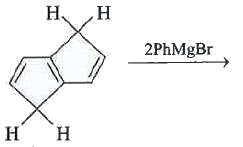The hydride ion H− is a stronger base than its hydroxide ion OH−. Which of the following reactions will occurs if sodium hydride (NaH) is dissolved in water ?
H−+H2O→ No rection
H−(aq)+H2O→H2O
H−(aq)+H2O(l)→OH−+H2
None of these
The correct Answer is:C
To solve the question regarding the reaction that occurs when sodium hydride (NaH) is dissolved in water, we can follow these steps:
Step 1: Understand the Reactants
Sodium hydride (NaH) consists of sodium ions (Na⁺) and hydride ions (H⁻). The hydride ion is known to be a strong base.
Step 2: Dissolution in Water
When NaH is added to water, it dissociates into its constituent ions:
NaH→Na++H−
Step 3: Reaction of Hydride Ion with Water
The hydride ion (H⁻) will react with water (H₂O). The reaction can be represented as:
H−+H2O→OH−+H2
Step 4: Products of the Reaction
From the reaction, we see that the products formed are hydroxide ions (OH⁻) and hydrogen gas (H₂).
Step 5: Identify the Correct Option
Now, we can evaluate the provided options based on the reaction we derived:
1. H⁻ + H₂O → No reaction (Incorrect)
2. H⁻ + H₂O → H₂O (Incorrect)
3. H⁻ + H₂O → OH⁻ + H₂ (Correct)
4. None of these (Incorrect)
Thus, the correct answer is option 3.
Final Answer
When sodium hydride (NaH) is dissolved in water, the reaction that occurs is:
H−+H2O→OH−+H2
Sodium hydride (NaH) consists of sodium ions (Na⁺) and hydride ions (H⁻). The hydride ion is known to be a strong base.
When NaH is added to water, it dissociates into its constituent ions:
NaH→Na++H−
The hydride ion (H⁻) will react with water (H₂O). The reaction can be represented as:
H−+H2O→OH−+H2
From the reaction, we see that the products formed are hydroxide ions (OH⁻) and hydrogen gas (H₂).
Now, we can evaluate the provided options based on the reaction we derived:
1. H⁻ + H₂O → No reaction (Incorrect)
2. H⁻ + H₂O → H₂O (Incorrect)
3. H⁻ + H₂O → OH⁻ + H₂ (Correct)
4. None of these (Incorrect)
When sodium hydride (NaH) is dissolved in water, the reaction that occurs is:
H−+H2O→OH−+H2
Topper's Solved these Questions
- BOOK - AAKASH INSTITUTE ENGLISHCHAPTER - HYDROGENEXERCISE - ASSIGNMENT (SECTION - D) (Assertion-Reason Type question)15videos
HYDROGEN
- BOOK - AAKASH INSTITUTE ENGLISHCHAPTER - HYDROGENEXERCISE - ASSIGNMENT (SECTION - B) (objective type question)38videos
HYDROGEN
- BOOK - AAKASH INSTITUTE ENGLISHCHAPTER - HYDROCARBONSEXERCISE - Assignment(Section - C) (Previous Years Questions)60videos
HYDROCARBONS
- BOOK - AAKASH INSTITUTE ENGLISHCHAPTER - M0ck test 26EXERCISE - EXAMPLE43videos
M0ck test 26
Similar Questions
Knowledge Check
- Question 1 - Select One or More
Which of the following reactions give aromatic ion ?
A B
B C
C D
D
- Question 2 - Select One or More
Which of the following reactions involve hydride ion transfer?
A2H−O∣∣C−HϴOH−−→H−O∣∣C−ϴO+CH3−OHB2H3C−Ot∣∣(C)−ϴOH−−−−−→ΔH3C−CH=CH−O∣∣C−HC2H3C−O∣∣C−HAl(OEt)3−−−−−→CH3−O∣∣C−O−CH2CH3D
- Question 3 - Select One
Which of the following compounds will react with sodium hydroxide solution in water ?
AC6H5OHBC6H5CH2OHC(CH3)3COHDC2H5OH
Which of the following compounds will react with sodium hydroxide solution in water ?
View SolutionHydroxide ion in the following reaction behaves as a/an
 View Solution
View SolutionWhich of the following ions will cause hardness in water sample?
View SolutionIn the reaction of sodium hydride and water:
View SolutionWhich of the following ions will cause hardness in water sample?
View Solution

